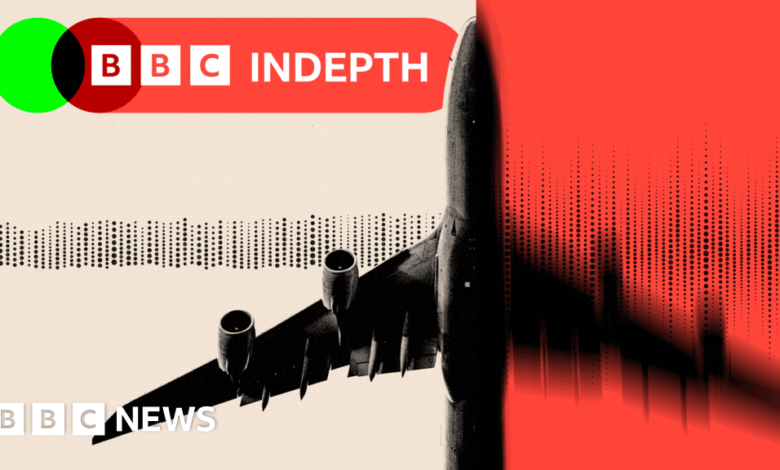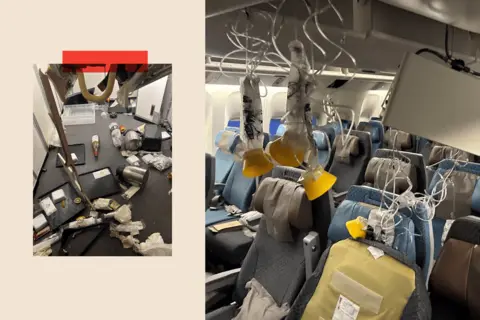Why plane turbulence is really becoming more frequent and severe


 BBC
BBCAndrew Davies was on his option to New Zealand to work on a Physician Who exhibition, for which he was undertaking supervisor. The primary leg of his flight from London to Singapore was pretty clean. Then instantly the aircraft hit extreme turbulence.
“Being on a rollercoaster is the one method I can describe it,” he remembers. “After being pushed into my seat actually exhausting, we instantly dropped. My iPad hit me within the head, espresso went throughout me. There was devastation within the cabin with folks and particles in every single place.
“Folks had been crying and [there was] simply disbelief about what had occurred.”
Mr Davies was, he says, “one of many fortunate ones”.
Different passengers had been left with gashes and damaged bones. Geoff Kitchen, who was 73, died of a coronary heart assault.
Loss of life as a consequence of turbulence is extraordinarily uncommon. There aren’t any official figures however there are estimated to have been roughly 4 deaths since 1981. Accidents, nevertheless, inform a unique story.
 REUTERS/Stringer
REUTERS/StringerWithin the US alone, there have been 207 extreme accidents – the place a person has been admitted to hospital for greater than 48 hours – since 2009, official figures from the Nationwide Transportation Security Board present. (Of those, 166 had been crew and will not have been seated.)
However as local weather change shifts atmospheric situations, specialists warn that air journey may turn into bumpier: temperature adjustments and shifting wind patterns within the higher environment are anticipated to extend the frequency and depth of extreme turbulence.
“We will count on a doubling or tripling within the quantity of extreme turbulence around the globe within the subsequent few a long time,” says Professor Paul Williams, an atmospheric scientist on the College of Studying.
“For each 10 minutes of extreme turbulence skilled now, that might improve to twenty or half-hour.”
So, if turbulence does get extra intense, may it turn into extra harmful too – or are there intelligent ways in which airways can higher “turbulence-proof” their planes?
The bumpy North Atlantic route
Extreme turbulence is outlined as when the up and down actions of a aircraft going via disturbed air exert greater than 1.5g-force in your physique – sufficient to elevate you out of your seat when you weren’t carrying a seatbelt.
Estimates present that there are round 5,000 incidents of severe-or-greater turbulence yearly, out of a complete of greater than 35 million flights that now take off globally.
Of the extreme accidents triggered to passengers flying all through 2023 – nearly 40% had been attributable to turbulence, in line with the annual security report by the Worldwide Civil Aviation Group.
 Brazil Photographs/LightRocket by way of Getty Photos
Brazil Photographs/LightRocket by way of Getty PhotosThe route between the UK and the US, Canada and the Caribbean is among the many areas identified to have been affected. Over the previous 40 years, since satellites started observing the environment, there was a 55% improve in extreme turbulence over the North Atlantic.
However the frequency of turbulence is projected to extend in different areas too in line with a current research – amongst them, elements of East Asia, North Africa, North Pacific, North America and the Center East.
The knock-on impact of local weather change
There are three predominant causes of turbulence: convective (clouds or thunderstorms), orographic (air circulation round mountainous areas) and clear-air (adjustments in wind route or velocity).
Every kind may deliver extreme turbulence. Convective and orographic are sometimes extra avoidable – it’s the clear-air turbulence that, because the title may suggest, can’t be seen. Generally it seemingly comes out of nowhere.
 KIRILL KUDRYAVTSEV /AFP by way of Getty
KIRILL KUDRYAVTSEV /AFP by way of GettyLocal weather change is a significant factor in driving up each convective and clear-air turbulence.
Whereas the connection between local weather change and thunderstorms is advanced, a hotter environment can maintain extra moisture – and that further warmth and moisture mix to make extra intense thunderstorms.
Linking this again to turbulence — convective turbulence is created by the bodily technique of air rising and falling within the environment, particularly inside clouds. And you will not discover extra violent up and downdrafts than in cumulonimbus, or thunderstorm clouds.
This was the reason for the extreme turbulence on Andrew Davies’s journey again in 2024.
A report by Singapore’s Transport Security Investigation Bureau discovered that the aircraft was “probably flying over an space of growing convective exercise” over south Myanmar, resulting in “19 seconds of utmost turbulence that included a drop of 178 toes in just below 5 seconds”.
 MediaNews Group/Boston Herald by way of Getty Photos
MediaNews Group/Boston Herald by way of Getty PhotosOne research from the US revealed within the Science journal in 2014 confirmed that for 1C improve in international temperature, lightning strikes improve by 12%.
Captain Nathan Davies, a business airline pilot, says: “I’ve seen extra giant storm cells spreading 80 miles plus in diameter in the previous couple of years, one thing you’d count on to be uncommon.”
However he provides: “The big cumulonimbus clouds are straightforward to identify visually except embedded inside different clouds, so we are able to go round them.”
Clear-air turbulence may additionally quickly rise. It’s attributable to disturbed air in and across the jet stream, (a fast-moving wind at round six miles within the environment, which is identical top as the place planes cruise).
Wind speeds within the jet stream travelling from west to east throughout the Atlantic can range from 160mph to 250mph.
There may be colder air to the north and hotter air to the south: this temperature distinction and alter in winds is beneficial for airliners to make use of as a tailwind to save lots of time and gasoline. However it additionally creates the turbulent air.
“Local weather change is warming the air to the south of the jet stream greater than the air to the north in order that temperature distinction is being made stronger,” explains Prof Williams. “Which in flip is driving a stronger jet stream.”
‘It ought to fear us all’
The rise in extreme turbulence – sufficient to elevate you out of your seat – may doubtlessly deliver extra incidents of harm, or probably demise in essentially the most extreme circumstances. And a few passengers are involved.
For Mr Davies, the prospect of extra turbulence is worrying. “Loads. Not only for me, however my kids too,” he explains.
“I am happy there hasn’t been an incident as extreme as mine however I believe it ought to fear us all”.
Greater than a fifth of UK adults say they’re terrified of flying, in line with a current YouGov survey, and worsening turbulence may make journeys much more of a nightmare for these folks.
As Wendy Barker, a nervous flyer from Norfolk, informed me: “Extra turbulence to me equals extra probability of one thing going incorrect and fewer probability of survival.”
Plane wings are, nevertheless, designed to fly via turbulent air. As Chris Keane, a former pilot and now ground-school teacher says, “you will not imagine how versatile a wing is. In a 747 passenger plane, below ‘harmful’ testing, the wings are bent upwards by some 25 levels earlier than they snap, which is basically excessive and one thing that may by no means occur, even in essentially the most extreme turbulence.”
For airways, nevertheless, there’s a hidden concern: that’s the financial prices of extra turbulence.
The hidden value of turbulence
AVTECH, a tech firm that displays local weather and temperature adjustments – and works with the Met Workplace to assist warn pilots of turbulence – means that the prices can vary from £180,000 to £1.5 million per airline yearly.
This contains the prices of getting to examine and preserve plane after extreme turbulence, compensation prices if a flight needs to be diverted or delayed, and prices related to being within the incorrect location.
 Kevin Carter/GETTY
Kevin Carter/GETTYEurocontrol, a civil-military organisation that helps European aviation perceive local weather change dangers, says that diverting round turbulence-producing storms can have a wider impression – for instance, if plenty of plane are having to vary flight paths, airspace can get extra crowded in sure areas.
“[This] will increase workload for pilots and air site visitors controllers significantly,” says a Eurocontrol spokesperson.
Having to fly round storms additionally means further gasoline and time.
In 2019 for instance, Eurocontrol says unhealthy climate “pressured airways to fly a million further kilometres, producing 19,000 further tonnes of CO2.”
With excessive climate predicted to extend, they count on flights might want to divert round unhealthy climate comparable to storms and turbulence much more by 2050.
“Additional driving up the prices to airways, passengers and [increasing] their carbon footprint.”
How airways are turbulence-proofing
Forecasting turbulence has acquired higher in recent times and whereas it’s not excellent, Prof Williams suggests we are able to appropriately forecast about 75% of clear-air turbulence.
“Twenty years in the past it was extra like 60% so thanks to higher analysis that determine goes up and up over time,” he says.
Plane have climate radar that may decide up storms forward. As Capt Davies explains, “Earlier than a flight, most airways will produce a flight plan that particulars areas of turbulence probably all through the route, based mostly on pc modelling.”
It’s not 100% correct, however “it offers an excellent thought mixed with different plane and Air Site visitors Management reviews as soon as we’re en-route”.
 RUNGROJ YONGRIT/EPA – EFE/REX/Shutterstock
RUNGROJ YONGRIT/EPA – EFE/REX/ShutterstockSouthwest Airways within the US just lately determined to finish cabin service earlier, at 18,000ft as an alternative of the earlier 10,000ft. By having the crew and passengers seated with belts on prepared for touchdown at this altitude, Southwest Airways suggests it’ll reduce turbulence-related accidents by 20%.
Additionally final 12 months, Korean Airways determined to cease serving noodles to its financial system passengers because it had reported a doubling of turbulence since 2019, which raised the chance of passengers getting burned.
From owls to AI: excessive measures
Some research have taken turbulence-proofing even additional, and checked out other ways to construct wings.
Veterinarians and engineers have studied how a barn owl flies so easily in gusty winds, and found wings act like a suspension and stabilise the pinnacle and torso when flying via disturbed air.
The research revealed within the Royal Society proceedings in 2020 concluded that “a suitably tuned, hinged-wing design may be helpful in small-scale plane…serving to reject gusts and turbulence”.
Individually, a start-up in Austria referred to as Turbulence Options claims to have created turbulence cancelling know-how for gentle plane, the place a sensor detects turbulent air and sends a sign to a flap on the wing which counteracts that turbulence.
These can cut back average turbulence by 80% in gentle plane, in line with the corporate’s CEO.
 NurPhoto by way of Getty
NurPhoto by way of GettyThen there are these arguing that AI could possibly be an answer. Fourier Adaptive Studying and Management (FALCON) is a sort of know-how being researched on the California Institute of Know-how that learns how turbulent air flows throughout a wing in real-time. It additionally anticipates the turbulence, giving instructions to a flap on the wing which then adjusts to counteract it.
Nevertheless Finlay Ashley, an aerospace engineer and member of Secure Touchdown, a group of aviation employees calling for a extra sustainable future in aviation, defined that a majority of these know-how are a while away.
“[They’re] unlikely to look on giant business plane throughout the subsequent couple of a long time.”
However even when turbulence does turn into extra frequent, and extra extreme, specialists argue this is not trigger for fear. “It is typically nothing greater than annoying,” says Captain Davies.
However it may imply extra time sitting down, with the seat-belt mounted.
Andrew Davies has already learnt this the exhausting method: “I do get much more nervous and do not sit up for flying like I used to,” he admits. “However I will not let it outline me.
“The second I sit down, my seat belt goes on and if I do must rise up, I decide my second – then I am shortly again in my seat, buckled up once more.”
Prime Picture credit score: Ivan-balvan by way of GETTY
BBC InDepth is the house on the web site and app for the perfect evaluation, with contemporary views that problem assumptions and deep reporting on the most important problems with the day. And we showcase thought-provoking content material from throughout BBC Sounds and iPlayer too. You possibly can ship us your suggestions on the InDepth part by clicking on the button under.
2025-07-29 23:00:00






